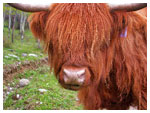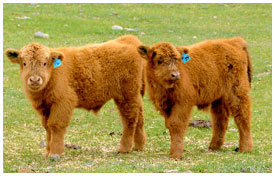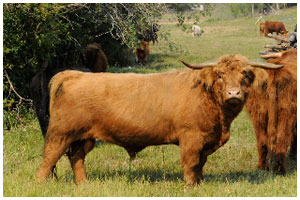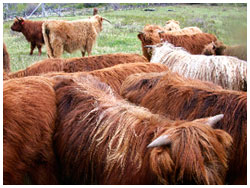Our Breeds: Highland Cattle
Highland cattle are an ancient breed, originating in the highlands and western isles of Scotland. Living there unchanged for centuries under rugged conditions and severe climate, the highland cow developed a thick, shaggy double coat, not backfat, to survive. Unlike many modern, commercial breeds, Highlands have not lost the ability to thrive on grass alone.
A herd of Highland cattle is called a FOLD.
Why Choose Highland Cattle?
1. Highland beef is lean, flavourful and tender.
 |
2. No cattle breed finishes better on grass, we believe, than the Highland. Highland beef can retain its tenderness while still lean and with all the health advantages of grassfed beef. The breed has never been altered to finish well on grain, and because the breed association insists that any registered Highland must be 100% Highland bloodlines there has never been any "breeding up," - adding other breeds to the herdbook. All Highland bulls are DNA'd before their offspring can be registered purebred, and spot DNA checking of cows and calves ensures that animals registered in the herdbook remain 100% pure Highland.
3. Highland cattle have retained their ancient attributes, allowing them to thrive in difficult environments. These attributes include:
a) The Highland's double coat ensures that the animal stays warm and dry even in the worst weather. The coarse outer layer is water and windproof while the fine, fluffy, inner layer is warm but allows heat to escape. In summer most Highlands will shed to a shorter, single layer summer coat. This system means that the animal needs less back fat and more feed is converted to meat than to fat.
 |
b) Maybe the most familiar attribute of the Highland; its hairy forelock, the dossan, is an adaptation to protect its eyes from wind, sun and insects. Pink eye is rare in the breed and yes, they can see very well.
c) The Highland's conformation is built for survival and for beef. Stocky, bulky and long bodied, the Highland produces a surprisingly large amount of beef for animals that may look low to the ground. Not a lot of feed and energy is put towards long legs which would only increase heat loss on cold days.
d) The Highland is known as a browser, not simply a grazer. It will eat leaves and twigs of brush like willow and aspen and wild rose, as well as forbes and grasses. The breed has been used in some countries as conservation grazers, to keep back invasive brush. This fondness for a wide range of vegetation helps give the beef its delicious flavour. It is also known for its ability to convert feed to energy very efficiently, so requiring less feed per pound of animal.
 |
e) One of the great ancient attributes the Highland has never lost is its ease of calving. Calves are born small but lively and twins are rare. Highland milk is known for its richness which contributes to the quick growth and good health of calves. Another ancient attribute, important in predator heavy areas, is the strong maternal instinct of the cow. Abandoned calves are rare; mother cows are usually devoted and caring. Although generally gentle as a rule cows with new calves should always be approached with caution.
7. Perhaps the most attractive characteristics of the Highland is its gentle temperament. Dogs and horses are not necessary to move these animals, they will quickly learn to move by voice and learn to enjoy being brushed or attended to in pasture. Despite their often forbidding appearance they are not flighty or aggressive by nature. Historically many were owned by Scottish crofters who would keep one for many years as the household cow. Over time they have been selected for their calm temperaments and ability to live in close proximity to humans.
 Surlach of Sweetbrier |
8. Highland folds are known for their easy-going bulls. The Highland bull is a calm, confident animal, easy to manage and happy at home.
9. Highlands are slow growing and slow to mature. Heifers are generally not bred until their second year. They are long lived and fertile however and it is quite usual for a Highland cow to continue producing a calf a year until she is well into her teens. Steers while often not reaching their full size until 20 to 24 months produce a full flavoured, well marbled beef not seen in younger animals.
 |
10. The Highland's handsome coats come in 9 shades - black, white, red, light red, yellow, silver dun, dun, light brindle and dark brindle; their horns may grow in a variety of handsome shapes. There is even a fair amount of variety in the size and conformation of the breed, which is of endless interest to breeders and admirers.
11. The Highland crosses well with other cattle breeds, particularly the British breeds. The Highland's hardy attributes, ease of calving and stocky, beefy build can add strength to any cattle herd. At our ranch we occasionally cross our Highland cows to a red angus bull, and have sold our Highland bulls for successful crossbreeding programs.
Docile by nature and gently handled in large pastures of mountain grasses and glacier-fed water, Tatlayoko Highland Cattle are finished on grass and the best Canadian hay, not grain, so the beef retains its naturally lean, low cholesterol attributes, while being naturally well marbled and succulent, with a flavour that may be more intense to those consumers used to beef finished on commercial feeds or grains in crowded, stress-filled feed lots. Grass fed has decided advantage over feedlot beef because of the linoleic acids that are naturally found in grass fed beef. These acids are powerful anti-oxidants and are not found in grain fed beef. A number of studies have shown that Highland beef is higher in protein and iron than other beef. It easily meets the criteria set out by the Canadian Heart and Stroke Foundation which recommends raw cuts with less than 10% fat.
You will find that grass fed beef is lean, without the sloppy, fatty, gelatinous taste of grain finished beef. This will mean you find it more firm and textured than the mass produced commercial product you may have come to think is quality beef.

Tatlayoko Highland Cattle are raised under natural conditions in the wind and sun of the wild Tatlayoko Valley, British Columbia. They receive only grass, fresh water, mineral, and hay in winter and spend their lives outside on sun blessed mountain pastures. Calving takes place on green grass on open pastures. From birth an effort is made to keep their lives healthy, calm and stress free No implants, hormones, steroids, nitrates, or antibiotic feeds are used.
Contact us to order our grassfed Highland beef - either cut and wrapped and frozen or for entire fresh never frozen sides (halves) and wholes - we can arrange shipments to the lower Mainland and Williams Lake, British Columbia.
In addition, this year we will be offering Highland cattle hides – the wonderful hairy hide of a steer, tanned to perfection for your wall, floor, sofa or bed, in a variety of natural colours. These can be shipped to addresses across Canada.
